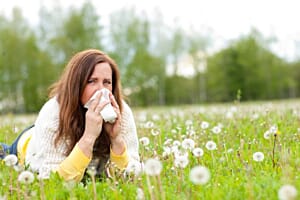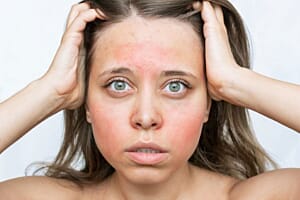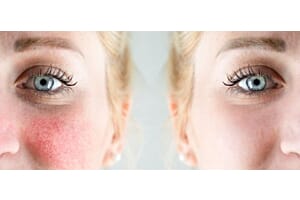Although there’s still some debate among skin specialists about what exactly causes contact dermatitis (CD), it’s generally agreed that CD is an inflammatory response to irritants and allergens as opposed to a skin barrier dysfunction, which is what causes eczema.
This makes early summer a particularly tricky time for CD sufferers as there are a number of triggers for contact dermatitis that are in abundance at this time of year.
Consultant dermatologist Dr Eva Melegh takes us through six of the most common summer triggers for CD and how best to minimise them;
1. Pollen Contact Dermatitis
Pollen is a common trigger for CD.
The exposed areas that are most commonly affected by airborne allergens like pollen are the face, hands, neck, upper chest, and forearms. Eyelid dermatitis and blepharitis is common with pollen and can sometimes be the only affected site. If pollen gets inside clothing or if you sit in pollen, the areas of skin that are covered by clothing can also get effected.

Reduce risk of CD from pollen
- Antihistamines can help calm down skin reactions from pollen.
- Invest in a protective eye gel that can be used around the eye area that is designed to reduce and manage eye eczema and eye dermatitis during the pollen season. Wear it daily either under make up on on its own. Hydrosil Dry Eye Gel contains a plant steriod that is safe for use around the eye area and brings instant relief to itching and inflammation from pollen triggered CD around the eye area.
- Remove outdoor clothes once in the house and shake them off outside before washing them.
- Shower (and rinse hair) and change to indoor clothes when returning home.
- Avoid getting into bed before washing off pollen from outside.
- Try not to sit or lie in long grass
- Avoid using hair products like hairspray or gel as this can cause pollen to stick to the hair and trigger CD around the hairline, behind the ears and on the neck area.
2. Sun Cream Contact Dermatitis
Ingredients in many suncreams can trigger CD, especially in the areas around the eyes.
Chemical filter sun creams can be more problematic for CD than mineral sun creams as they tend to have a high incidence of skin reaction.

 Reduce CD from sun creams
Reduce CD from sun creams
- Use a de-sensitising barrier cream under suncreams. Kalme Undercoat contains a specific ingredient that helps dampen down the skin’s reactivity and can be worn under all suncreams to reduce the risk of CD reactions.
- Avoid sun creams with perfumes in
- Stick to mineral sun creams rather than chemical filters. Zinc oxide is the best mineral SPF for skin prone to CD because it has the lowest reactivity when exposed to UV rays. Kalme Day Defence SPF25 has a pure zinc oxide SPF and also a ingredient to help dampen down redness and is certififed for use on sensitive skin.
3. Dust Mite Contact Dermatitis
Dust mites are a known trigger for CD and in early summer the prevalence of dust mites often increases due to an increase in humidity, which causes them to start reproducing faster.

Reduce risk of CD from dust mites
- Use a dehumidifier to keep humidity levels between 40 and 45% to prevent dust mites from reproducing.
- Keep the indoor temperature thermostat set below 70
- Air your duvet and non-washable bed clothes but be careful not to also get these covered in outdoor pollen too. Air them in a place not close to plants or grass.
- Hoover carpets more regularly and, if possible, get carpets steam cleaned professionally at the start of Spring.
- Wash bedding such as pillowcases, sheets and sheet protectors on a high heat wash weekly. Putting bed laundry through a hot dryer also kills dust mites
- Children’s soft, stuffed toys are known to harbour dust mites. Putting them in the dryer for an hour, freezing them overnight or washing them in water mixed with eucalyptus oil are effective ways to reduce dust mite numbers.
4. Pet Hair Contact Dermatitis
In eary summer pets tend to start shedding more hair than normal as they get rid of thicker winter coats as the warmer weather arrives.
This means that CD triggered by pet hair, which often appears as hives (small red raises bumps and rashes), is often much more common in warmer weather. Pet hair can often be the most severe of all the hot weather triggers for CD sufferers.

 Reduce risk of CD from pet hair
Reduce risk of CD from pet hair
- Keep animals out of bedrooms and away from sofas and armchairs
- Have hard surface areas where pets rest and sleep
- Ask a person without allergies to brush and wash your pet at least once a week, outside of the house
- Use vacuum cleaners with HEPA filters that remove allergens from surfaces and the air, trapping them inside the filter.
- Change clothes after prolonged contact with your pet.
5. Sweat Contact Dermatitis
Perspiration (sweat) is one of the most commonly reported aggravators in CD and early summeris a time when sweating increases due to the sudden and multiple changes in temperature during temperamental warm weather.

Sweat mainly consists of water, urea, lactate, and minerals. A buildup of these chemicals on the skin can be a trigger for CD particularly in areas of the skin that build up sweat and are not easily aired such as the groin, under the armpits and breasts, in the cracks of arms and knees, on the neck under longer hair and on the scalp. Itchy scalp and scalp dermatitis is very common in Spring weather.
Reduce risk of CD from sweat
- Wear clothing in light layers, that are easy to remove as soon as it gets hot and which keep the skin more ventilated.
- Wear natural fabric and looser fitting underwear
- Use hair products that don’t contain perfumes or chemicals and that specifically help reduce itching and inflammation of scalp dermatitis. Hydrosil Scalp Shield Tonic is a leave in scalp tonic that contains a plant sterol that reduces itchy scalp as well as plant prebiotics to help repair damaged scalp barrier function to reducing flaky scalp and dry scalp.
- Avoid synthetic fabrics that trap in heat
- Shower off dried sweat as soon as you get in. Leaving old and dried sweat on skin for long periods of time increases the risk of CD.
- Moisturise straight after showering, preferably with a salve to make sure vulnerable areas do not become dry and irritated, which can happen after increased perspiration. Hydrosil Turmeric Butter & Milk Salve is designed for skin prone to dermatitis and eczema which contains ingredients to hydrate areas of dry sensitive skin and also calm down inflammation via its high content of turmeric and soothing hypoallergenic donkey milk.
6. Public Seating Contact Dermatitis
As the warmer weather arrives and we risk baring our legs and move into wearing shorts and skirts it’s important for CD sufferers to take extra care when sitting on any public seating areas or on public transport.

Public seating areas and seats on public transport are frequently washed with industrial cleaning products which can cause havoc with skin prone to CD.
In addition, materials like concrete and some plastics contains chemicals that can trigger CD.
Reduce risk of CD from public seats
- Avoid direct skin contact with public seating materials
- If wearing shorter garments of clothing its helpful to always carry a small natural fabric towel or scarf with you to place on the public seat to avoid skin contact with the seat.








